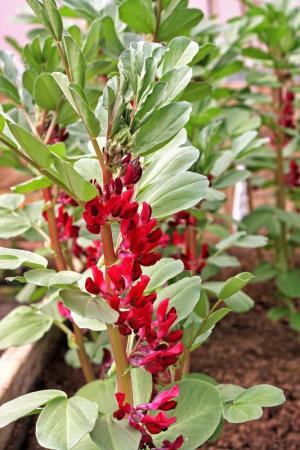Grow fava beans for lovely flowers and nutrition benefits
In the 6th century B.C., this man believed the earth was round. He was no head-in-the-clouds philosopher wimp and actually earned several Olympic titles for winning fistfights. But Pythagoras also had some odd beliefs, such as condemning eating fava beans because they contained the souls of the dead.
Souls of the dead or not, the cool days of early spring are best for planting your favas. Most fava beans have white blossoms, but the rare Crimson Flowered Fava (Vicia faba) is an old (1778) variety sporting brilliant-red flowers that are stunning in a garden or in a vase.
This red-flowered broad bean was saved from extinction when Miss Rhoda Cutbush from Kent (UK) gave her remaining four seeds to the Henry Doubleday Research Association, which grew them out for its Heritage Seed Library and re-introduced them to the seed trade.
These delicious beans produce 6-inch pods on three-foot-tall stalks. The plants are beautiful enough to plant in an ornamental border.
Fava beans, also called broad beans because of their wide, flat shape, grow with multiple stems. Each pod will contain two to three medium-sized green seeds.
Fava beans are a good source of protein, dietary fiber, vitamins B1, B9 and B6 as well as a good source of minerals including copper, iron, and manganese. They also contain substances that might lower blood cholesterol levels and even help with digestion.
Young, tender pods can be eaten whole, like green beans, although the beans are most often added to soups and stews. Fava beans are a traditional side dish for lamb, poultry and fish. The sweet flavor with hints of fresh grass goes well mixed with garlic, tomato, onions, celery and carrots. The tender new leaves are also edible, along with the colorful flowers.
Plant fava beans as early in the spring as you can dig the soil. Choose a sunny spot with soil that drains well. To help the seeds germinate, soak them in water for 12 to 24 hours before planting.
Sow the seeds 1 to 2 inches deep, 6 inches apart in rows 2 feet apart. The seeds will germinate in a week to 10 days. Thin the plants to stand at least 8 inches to a foot apart. Keep the planting site moist but not soggy.
Like most beans, favas are self-pollinating. The brilliant flowers attract pollinators such as bees and hummingbirds, so they may cross-pollinate if other varieties of fava are planted nearby.
To save your own seeds for next season, let the plants die down. The seed pods will begin to turn black as they dry. You can pick the seeds before they’re fully dry and finish drying them indoors before carefully shelling the beans.
Before cooking, you will need to remove the outer skin of the beans. You can easily just pop the beans out of their skins. Use the shelled beans immediately, or store them in the refrigerator for a few days.
Plant fava beans in the cold early spring, and soon enough you will have armloads of brilliant red flowers and delicious fava beans for a hearty meal. Just try not to think that they may contain the souls of the dead.





















































